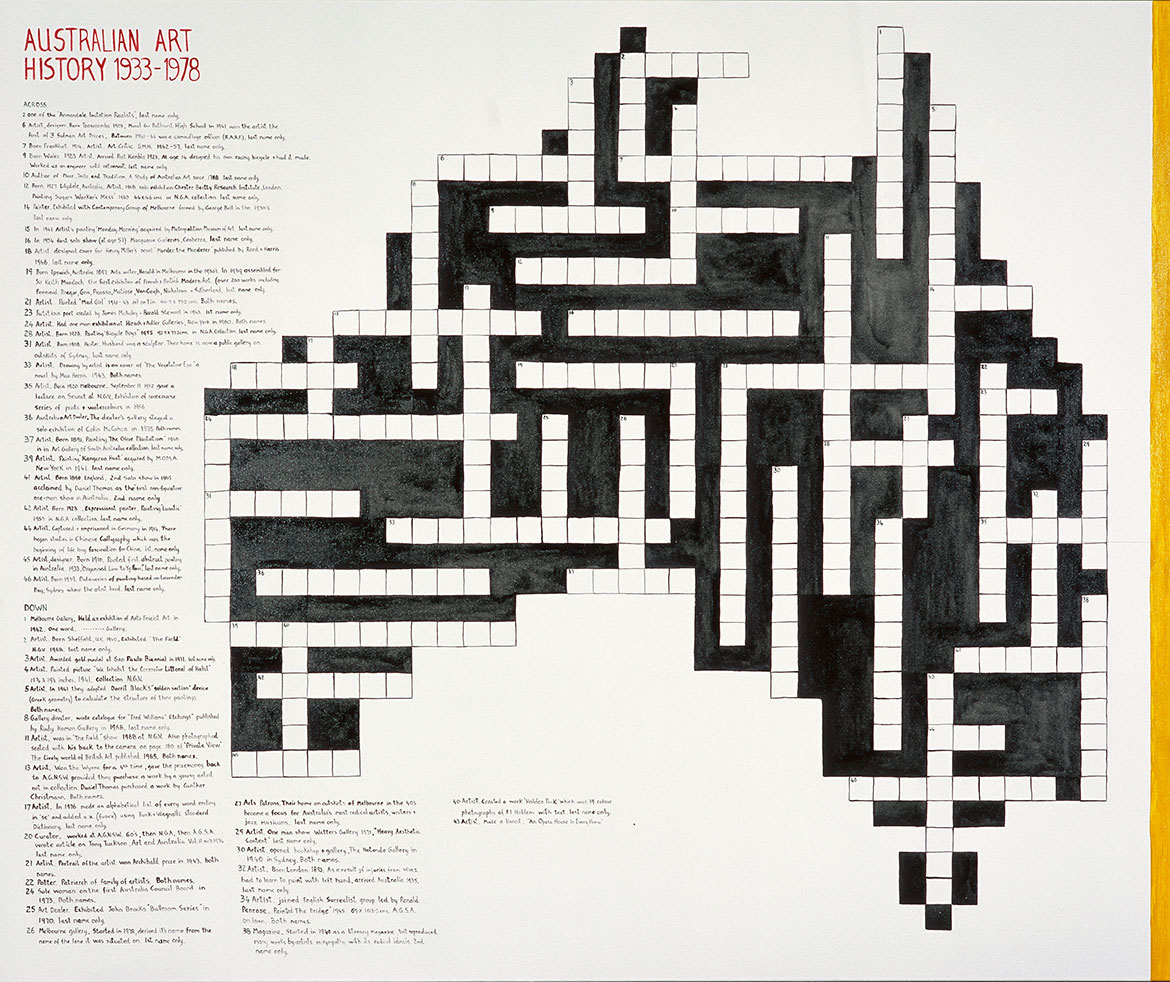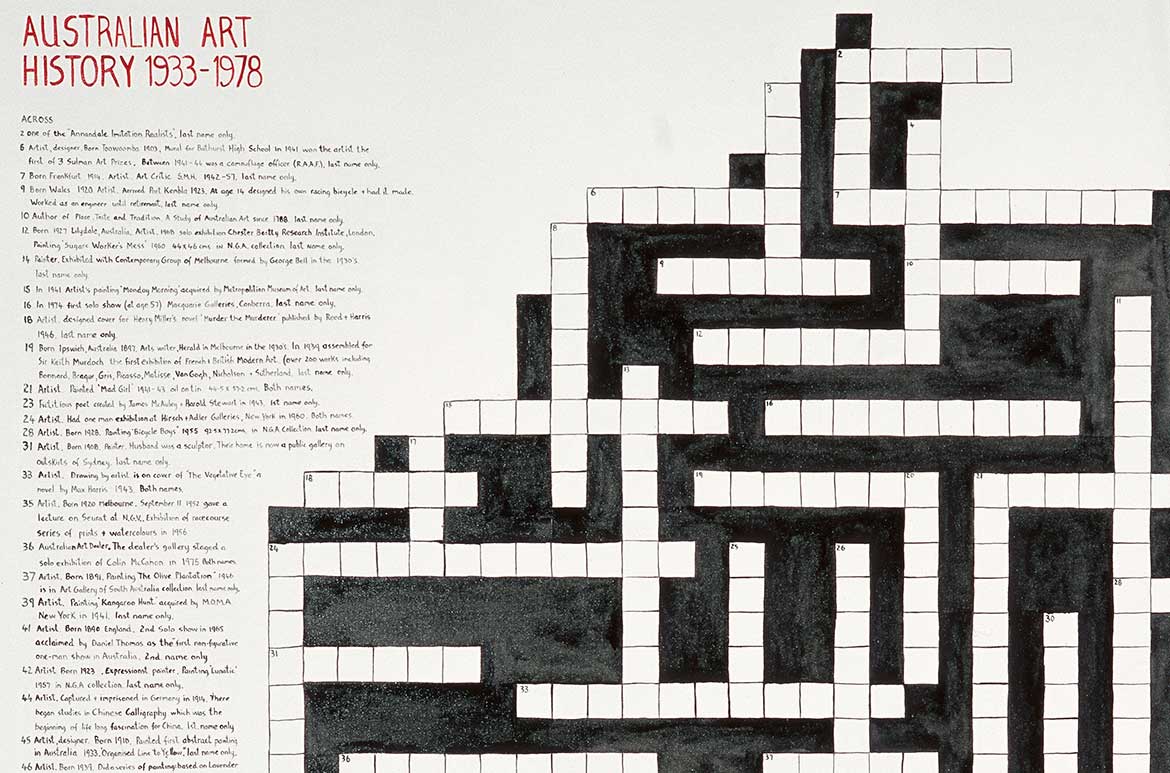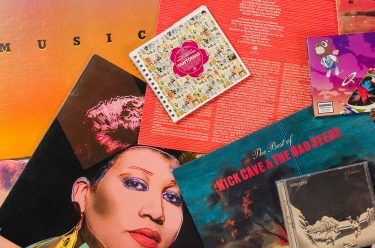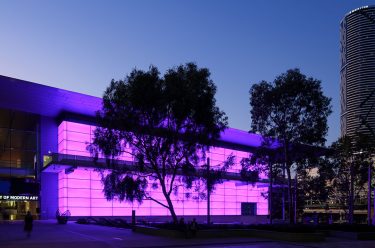Here are the answers to Noel McKenna’s crossword Australian Art History 1933–1978. The work is a larger-than-life crossword in the shape of Australia, intended for an in-crowd interested in Australian art history of the twentieth century. The crossword questions were published in a previous blog, how many did you get right?
SIGN UP NOW: Subscribe to QAGOMA Blog for the latest announcements, acquisitions, behind-the-scenes features, and artist stories.

Across
2. BROWN / The Annandale Imitation Realists (also known as Imitation Realism) was a short-lived collaborative group of mixed media avant-garde artists formed in Sydney in 1961, Mike Brown (1938-97) was a founding member.
6. ANNAND / Douglas S Annand (1903-76) won the Sir John Sulman Prize in 1941 with Set of Historical murals – painted in oils on plaster – Boys’, in 1947 with Mural “in situ”, Messrs. Jantzen (Aust.) Pty. Ltd., Lidcombe and in 1951 with Mural – Restaurant R.M.S. “Oronsay” (in Situ)
7. HAEFLINGER / In 1941 Paul Haefliger (1914-82) was appointed art critic for the Sydney Morning Herald, a position he held until 1957.
9. TANNER / In 1934 when Edwin Tanner (1920-80) was attending the Wollongong Junior Technical College he designed his own racing bike and formed a cycle club.
10. SMITH / Bernard William Smith (1916-2011) was an Australian art historian, art critic and academic, considered one of the most eminent art historians of the 20th century.
12. WHISSON / Ken Whisson (b.1927) traveled widely, producing a range of landscapes, still life, figure work and portraits. These works show the beginnings of the style he is recognised for – simplified details, distorted forms and the manipulation of perspective and the relationship between figures or objects and ground. Whisson’s blurring of the line between figuration and abstraction was unique in Australian art at the time.
14. SIME / Ian Sime (1926-89) was a council member of the Melbourne Contemporary Art Society and vice- president from 1956-62. He was interested equally in the philosophy and technology of painting. He adopted surrealist methods and ideas from about 1940.
15. DRYSDALE / George Russell Drysdale (1912-81) was influenced by abstract and surrealist art, and created a new vision of Australia.
16. GASCOIGNE / Rosalie Gascoigne (1917-99) is best known for her wall-based assemblages, which brought diverse materials from everyday life into new frames of reference. Gascoigne worked with items that had been discarded and left to weather, finding beauty in them that would normally be overlooked.
18. NOLAN / Henry Miller’s novel’s original red wrappers with black lettering was designed by Sidney Nolan (1917-92).
19. BURDETT / Basil Burdett (1897-1942) was a journalist, art dealer and critic.
21. JOY HESTER / Joy Hester (1920-60) was a member of the Angry Penguins who played an important role in the development of Australian modernism.
23. ERN / Ernest Lalor ‘Ern’ Malley was a fictitious poet and the central figure in Australia’s most famous literary hoax. He and his entire body of work were created in one day in 1943 by conservative writers James McAuley and Harold Stewart in order to hoax Max Harris and his modernist magazine Angry Penguins.
24. ALBERT TUCKER / Albert Tucker (1914-99) was responsible for reinvigorating and re-mythologising the Australian landscape.
28. OLSEN / John Olsen (1920-99) is well known for his energetic and distinctive painting style, his primary subject is landscape.
31. LEWERS / Margo Lewers (1908-78) was an abstract artist who worked across the media of painting, sculpture, tapestry, ceramics and the domestic arts.
33. SIDNEY NOLAN / Sidney Nolan (1917-92) is perhaps Australia’s best known painter, a reputation he has held since the early 1960s.
35. BRACK / John Brack (1920-99) was a member of the Antipodeans group. Brack is often described as an anti-romantic painter, he seeks inspiration in the people he sees around him.
36. RAY HUGHES / Art dealer Dr Raymond (Ray) Robert Hughes (1946–2017) was one of Australia’s most flamboyant and passionate advocates for artists.
37. BLACK / Dorrit (Dorothea) Foster Black (1891-1951) began her career in earnest in 1921 and she is know as a painter and printmaker of the Modernist school.
39. PURVES SMITH / The paintings of Peter Purves Smith (1912-49) are recognised for their surrealist undertones and idiosyncratic wit. Purves Smith aimed for his works to be ambiguous, disturbing or shocking.
41. BALSON / Abstract painter Ralph Balson (1890-1964) first earned his living as a house painter, it was not until 1920, at the age of 30, that he began his career in art.
42. MOLVIG / Jon Molvig (1923-70) is considered a major developer of 20th-century Australian expressionism.
44. IAN / Ian Fairweather (1891-1941) remains one of Australia’s most eminent artists. His distinctive visual vocabulary sets him apart from his contemporaries, and his paintings stand as highly individual statements within the broader canvas of modern Australian art.
45. ATYEO / Sam Atyeo (1910-90) was a leading figure among the ‘moderns’ in Melbourne in the early 1930s. Atyeo believed that visual art should be appreciated for its abstract formal qualities of line and colour.
46. WHITELEY / Brett Whiteley (1939-92) at 21 was awarded an Italian Travelling Scholarship. Whiteley traveled and exhibited widely in Europe and the United States until he returned home to Australia in 1969, rapidly establishing himself as the pre- eminent young artist in the country, and achieving both popular and critical acclaim. In 1991 Whiteley was awarded an Order of Australia.

Down
1. ATHENAEUM / The Athenaeum Art Gallery was established in Melbourne in 1910 and operated until 1971.
2. BOOTH / Peter Booth (b.1940) is a figurative and surrealist painter.
3. ASPDEN / David Aspden (1935-2005) was a prominent painter in the late 1960s and 1970s in the ‘hard edge’ or ‘colour field’ style.
4. GLEESON / James Gleeson (1915-2008) was a painter, writer, art critic and arts administrator for over sixty years. Gleeson is widely regarded as Australia’s leading surrealist.
5. JEFFERY SMART / Jeffrey Smart (1921-2013) was Australia’s pre-eminent painter of the contemporary world, though distinguished from realism by a stringent theoretical base and sure grasp of painterly tradition.
8. MOLLISON / James Mollison AO (b.1931) was acting director of the National Gallery of Australia 1971-77 and Director 1977-90 and Director of the National Gallery of Victoria 1989-95.
11. MICHAEL JOHNSON / Michael Johnson (b.1938) is an abstract painter where colour, space and form are highly distilled into abstract works.
13. SALI HERMAN / Sali Herman (1898-1993) played an important role in the Sydney art scene from the 1940s to 1960s. A dedicated painter, he exhibited regularly in solo exhibitions and with groups such as the Contemporary Art Society, the Contemporary Group and the Society of Artists. He won a number of major art prizes, including the Wynne Prize (AGNSW) in 1944, 1962, 1965 and 1967 and the Sulman Prize (AGNSW) in 1946 and 1948.
17. PARR / Mike Parr (b.1945) rapidly attracted attention early in his career as an artist by performing and documenting actions that confronted and unsettled the viewer’s role as a passive bystander. Many of his performances involved inflicting minor but painful mutilations on his body, prompting the audience to sense some obligation to intervene or otherwise prevent these acts. Parr employs ritualised, cathartic self-mutilation in an attempt to deconstruct the rational, socialized self.
20. THOMAS / Daniel Thomas (b.1931) is a major force in Australian art curatorship.
21. JOSHUA SMITH / Joshua Smith (1905-95) was well known for his portraits, landscapes and still lifes. William Dobell entered a portrait of Smith in the 1943 Archibald Art Prize which won amongst much controversy and publicity. It caused an argument over whether the portrait was a caricature of Smith or could be classified as a true representation, resulting in a publicised court case.
22. MERRIC BOYD / Merric Boyd (1888-1959) is the best known of early Australian potters and the first to produce a consistently high quality body of work.
24. ANN LEWIS / Ann Lewis (1935-2011) was one of Australia’s most influential and loved patrons of the arts
25. KOMON / Rudy Komon (1908-82) was an art dealer and gallery director.
26. NIAGARA / Niagara Galleries is a modern and contemporary art gallery established in 1978.
27. Reed / John Reed (1901-81) was an art editor and patron, notable for supporting and collecting of Australian art and culture with his wife Sunday Reed.
29. DANKO / Aleks Danko (b.1950) is one of Australia’s foremost conceptual artists. Danko’s practice has consistently explored aspects of Australian cultural beliefs and events as well as notions of aesthetic value and the institutionalisation of art.
30. CARL PLATE / Carl Olaf Plate (1909-77) was a prominent Australian modernist painter and collage artist.
32. HAWKINS / Harold Frederick Hawkins (1893-1977) an Australian modernist painter. He was discharged from the Western Front on 3 February 1919, after a series of twenty operations saved his arms from amputation, though his right hand remained lifeless and the left became a less-than-full-strength painting hand.
34. JAMES CANT / James Cant (1911-82) was a modernist painter, like many of the ‘moderns’ he left Australia in 1934 and travelled overseas.
38. PENGUINS / Angry Penguins was an Australian literary and artistic avant-garde movement of the 1940s
40. ROONEY / Robert Rooney (1937-2017) was an art critic and a leading figure in Australian Conceptual art.
43. ERIC THAKE / Eric Thake (1904-82) used elements of surrealism to capture the mood of the Australian landscape.
Subscribe to YouTube to go behind-the-scenes / Hear artists tell their stories / Read about your Collection / Discover more about Noel Mckenna
Australian Art History 1933–1978 was included in ‘Noel McKenna: Landscape – Mapped‘ at the Queensland Art Gallery (QAG) 18 November 2017 until 2 April 2018.
Feature image detail: Noel McKenna’s Australian Art History 1933–1978
#NoelMckenna #QAGOMA


